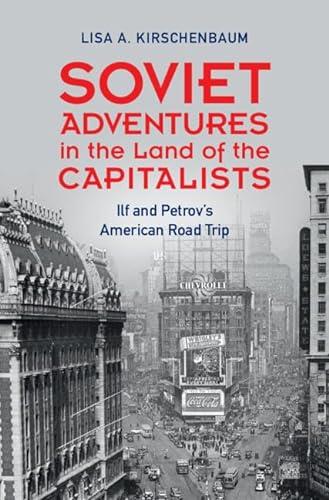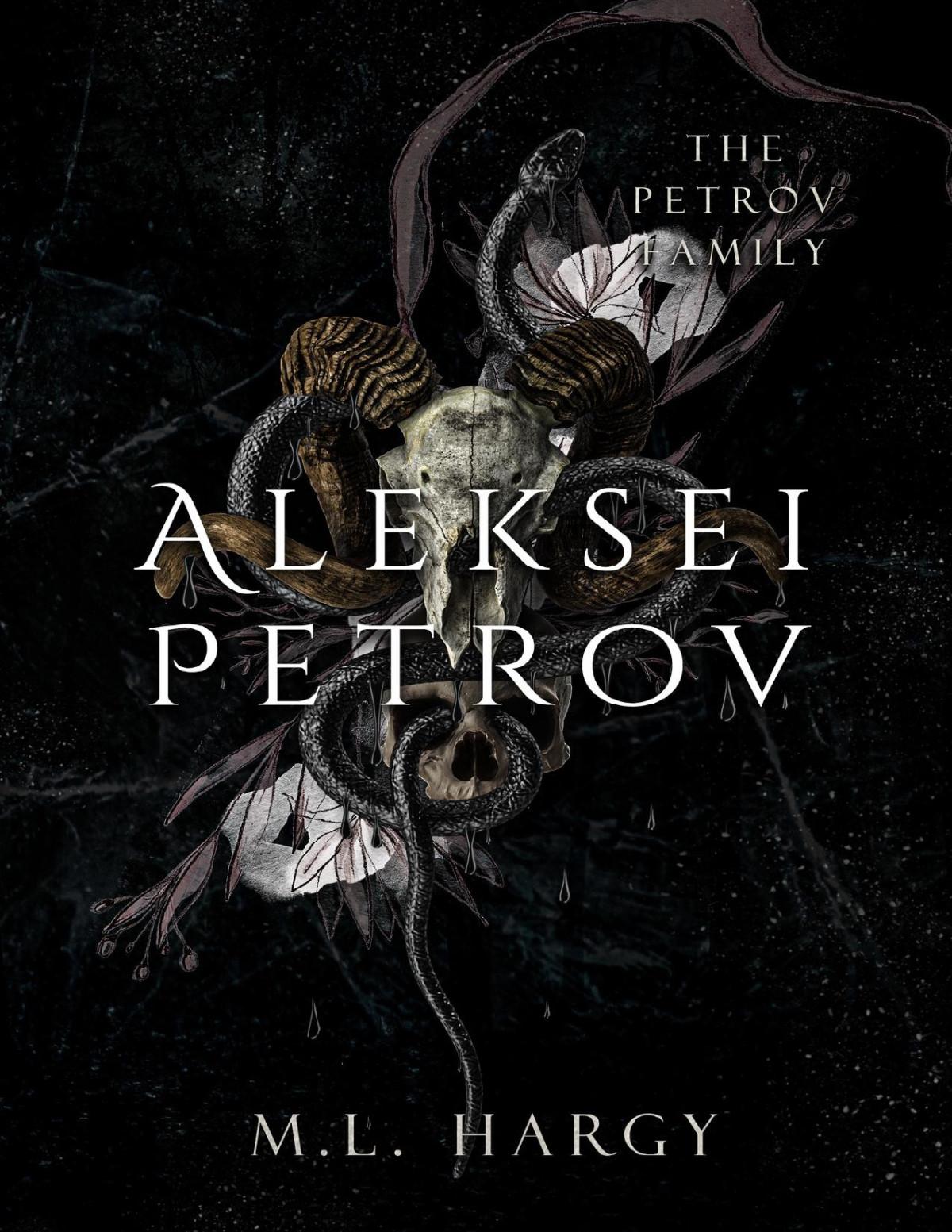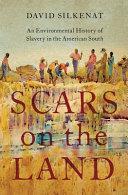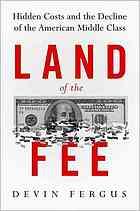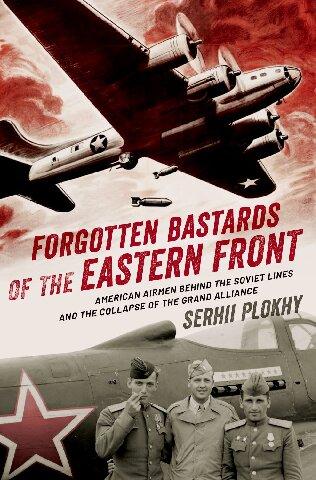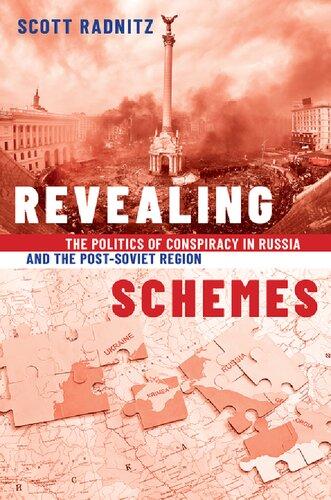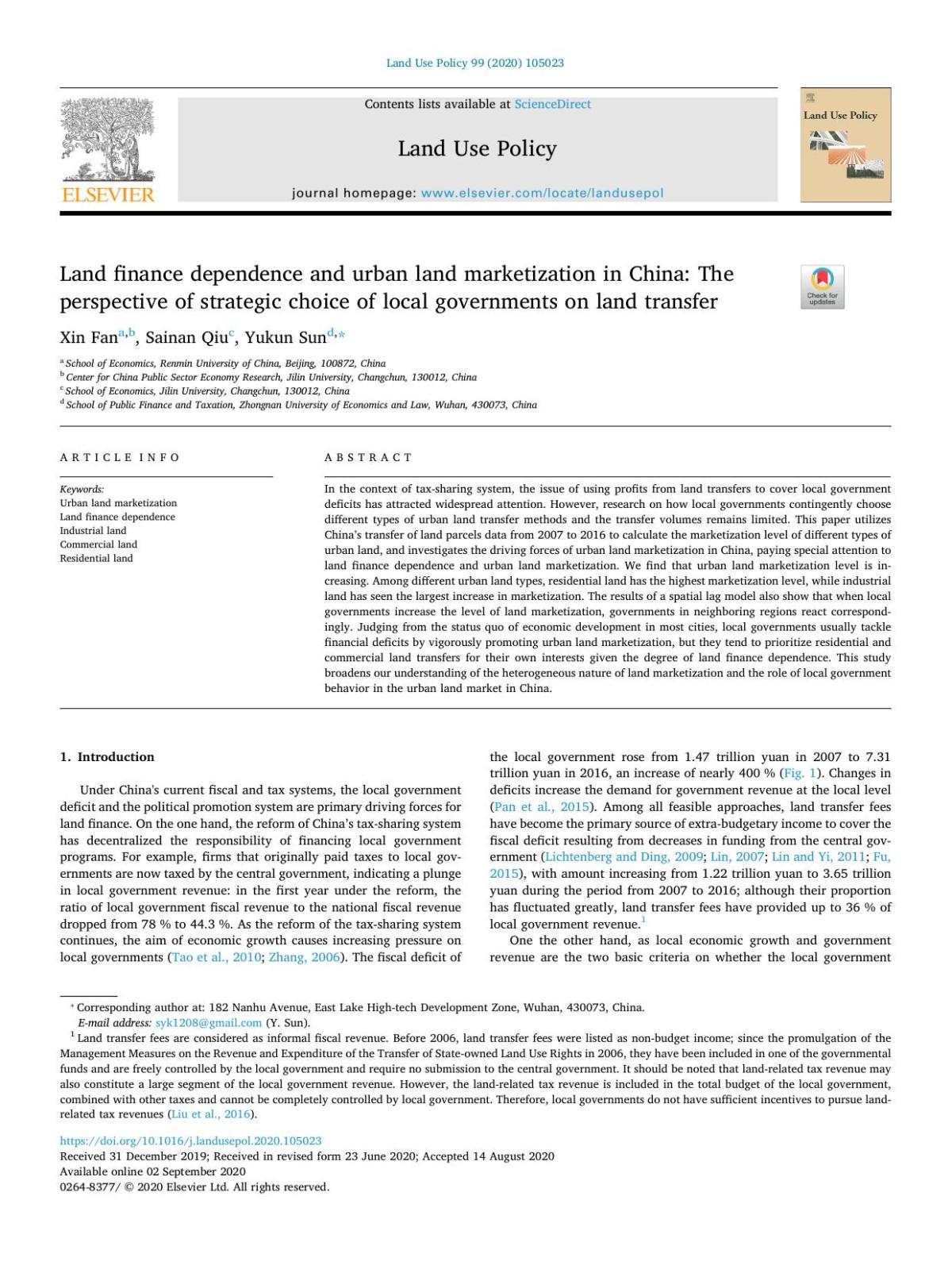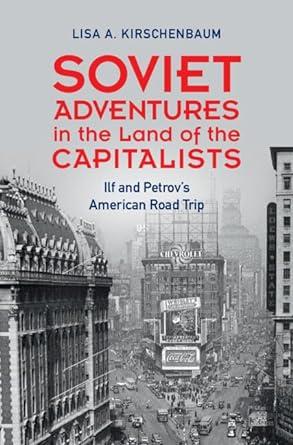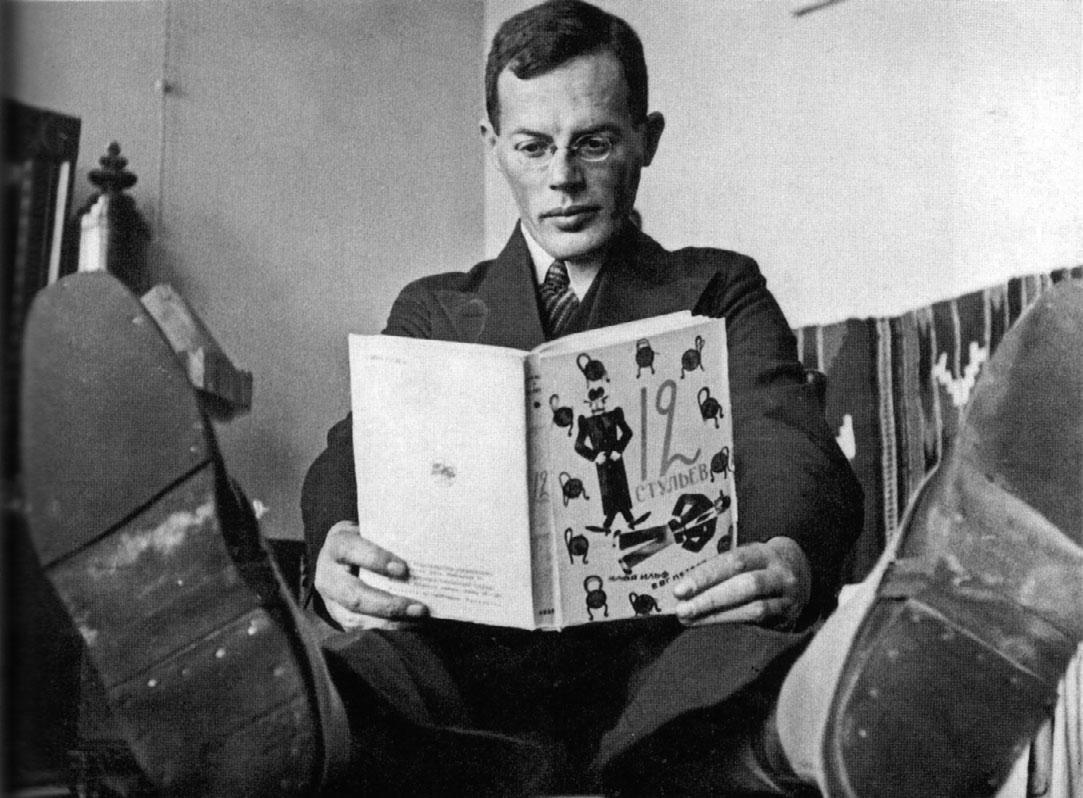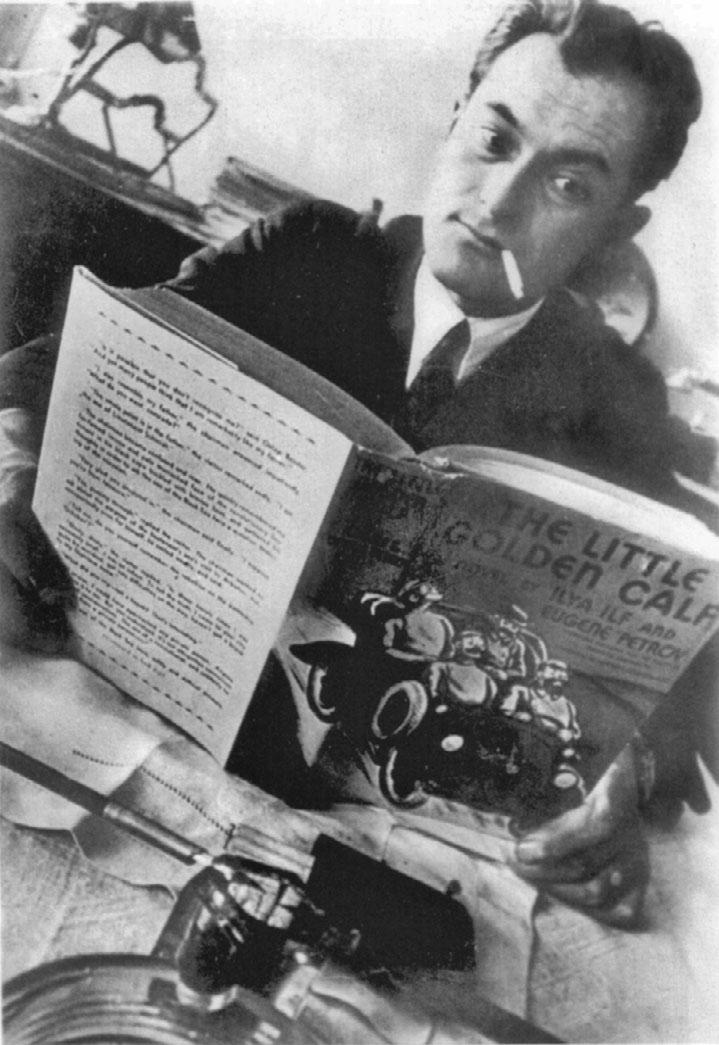NoteonTransliterationandTranslation
Thepagesthatfollowmixtwosystemsoftransliteration.Inthenotes, IusetheLibraryofCongresssystemwithoutdiacriticalmarks.Inthe text,IfollowcommonEnglishusageandomitsoftsigns – soIlʹiaIlʹfand EvgeniiPetrovbecomeIlyaIlfandEvgenyPetrov.
IlfandPetrovoftenincorporatedtransliteratedEnglishwordsand phrasesintotheirRussiantext.Tocommunicatetheireffortstoreplicate thesoundofAmericanspeech,Itransliterate,ratherthantranslatethese. Wherethemeaningmaybeunclear,Iprovideatranslationinbrackets.
InretracingIlfandPetrov’sroadtrip,Iusedboththe1937editionof theirbook OdnoetazhnaiaAmerika (One-StoryAmerica)andCharles Malamuth’s1937Englishtranslation, LittleGoldenAmerica.Ifthetranslationismyown,Icite OdnoetazhnaiaAmerika (asOA)inthenotes. IfIquoteMalamuth’stranslationwithnoorminoralterations,Iciteit first(asLGA)inthenotes.Ilikewisedrewontheserializedphotoessay IlfandPetrovpublishedinthejournal Ogonek,aswellasAnneFisher’s translation, IlfandPetrov’sAmericanRoadTrip,editedbyErikaWolf. WhenIusethetranslation,Iciteit(asART)inthefootnote.Unless indicated,allothertranslationsaremyown.
Thetitle OdnoetazhnaiaAmerika ,literally “One-StoryAmerica,” defieselegantEnglishtranslation.Ihaverendereditas Low-Rise America toavoidthedoublemeaningof “story” inEnglish.
Abbreviations
ARTErikaWolf,ed., IlfandPetrov’sAmericanRoadTrip:The 1935TravelogueofTwoSovietWritersIlyaIlfandEvgeny Petrov,trans.AnneO.Fisher(NewYork:Cabinet Books,2007).
FRUSUnitedStatesDepartmentofState, ForeignRelationsofthe UnitedStates:TheSovietUnion,1933–1939 (Washington, DC:USGovernmentPrintingOf fice,1933–1939).
LGAIl0 iaIl0 fandEvgeniiPetrov, LittleGoldenAmerica:Two FamousSovietHumoristsSurveytheUnitedStates,trans. CharlesMalamuth(NewYork:FarrarandRinehart,1937).
NACPNationalArchives,CollegePark,Maryland NYT NewYorkTimes
OAIl0 iaIl0 fandEvgeniiPetrov, OdnoetazhnaiaAmerika (Moscow:Khudozhestvennaialiteratura,1937).
PIAIl0 iaIl0 fandEvgeniiPetrov, OdnoetazhnaiaAmerika:Pis0 maiz Ameriki,ed.A.I.Il0 f(Moscow:Tekst,2003).
ZKIl0 iaIl0 f, Zapisnyeknizhki,1925–1937:Pervoepolnoeizdanie, ed.A.I.Il0 f(Moscow:Tekst,2000).
Introduction
Weknew.Therewasnoneedtohurry.Itwastoosoontogeneralize. Firstofall,wemustseeasmuchaspossible.
IlfandPetrov, LittleGoldenAmerica
Everydetailoftheadventuresoundsimplausible.In1935,twoSoviet humoristsundertooka10,000-mileroadtripfromNewYorkto Hollywoodandback,accompaniedonlybytheirguide,agregarious RussianJewishimmigrant,andchauffeur,hisRussian-speaking, American-bornwife.ThattheSovietUnionunderStalinevenhad humoristswillcomeasasurprisetomany.ButIlyaIlfandEvgeny PetrovweregenuineSovietfunnymen,thecoauthorsoftwobeloved satiricalnovels, TheTwelveChairs (1928)and TheLittleGoldenCalf (1931).Evenmoresurprisingforthoselookingbackthroughtheprism ofColdWarhostility,neithertheFBInortheSovietpoliticalpolice(the NKVD)seemstohaverestrictedthefreewheelingtrip.1
IlfandPetrovarrivedintheUnitedStatesatamomentofhopeful transition.Thefamineandshortagescausedbythecollectivizationof agricultureandStalin’scrashindustrializationprogram(theFirstFiveYearPlan,1928–1932),hadeased.Duringthe “threegoodyears ” ofthe decade,1934–1936,lifeforSovietcitizenswasbetterifnotquite,as Stalinfamouslyasserted,morejoyous.2 TheboomingSovieteconomy offeredanoptimisticcontrasttotheWestsufferingthroughtheGreat Depression.Inthearts,themethodofsocialistrealismhadyettobe
1 JonathanWaterlow, “SanctioningLaughterinStalin’sSovietUnion,” HistoryWorkshop Journal,no.79(2015):201–202;DinaFainberg, ColdWarCorrespondents:Sovietand AmericanReportersontheIdeologicalFrontLines (Baltimore:JohnsHopkinsUniversity Press,2021).TheFBIlearnedofthetripinconnectionwithaninvestigationofDonald OgdenStewartandEllaWinter,whoweremarriedin1939; “SolomonA.Trone:Internal Security – R,” 19October1945,FBI77-HQ-27252(TroneFBI).In1950,informantsof “knownreliability,” whohadknowntheirguideSolomonTrone “intimately” between 1928and1934,toldanFBIagentthattheSovietauthoritieswere “highlysuspicious” of himas “possiblyanAmericanIntelligenceAgent,” Report20June1950.
2 SheilaFitzpatrick, EverydayStalinism:OrdinaryLifeinExtraordinaryTimes:SovietRussia inthe1930s (NewYork:OxfordUniversityPress,2000),7.
rigidlycodified.Intherealmofforeignaffairs,theSovietstate ’s 1933establishmentofdiplomatictieswiththeUnitedStatesappeared topresagemoreopenrelationswiththeWest.Indeed,thetripseemed designedtopromotefriendlyculturalexchange.
BythetimeIlfandPetrovpublishedtheiraccountoftheirAmerican travels,thegoodyearshadended.TheAugust1936showtrialofStalin’s politicalopponentsproducedmorethanadozendeathsentencesanda paroxysmofxenophobia.TheGreatPurgesof1937–1938oftentargeted culturalandpoliticalelites,whoaccusedeachotherofideologicalfailings andparticipationinvastandfar-fetchedconspiraciesinvolvingforeign intelligenceagencies.Supposedlyimplementedtorootouthidden enemieswhomightorganizealethal fifthcolumnintheeventofwar, thepurgescoincidedwithmountingdistrustoffriendly,orindeedany relationswiththecapitalistworld.
Thus,themostmindbogglingfeatureofIlfandPetrov’sadventureis thefactthatin1937,attheheightoftheStalinistterror,whenanysortof connectiontoforeignersraisedsuspicionsoftreasonorespionage,their AmericantraveloguewaspublishedinboththeSovietUnionandthe UnitedStates.3 Despitethegrimpoliticalclimate,theirphotoessay “AmericanPhotographs” andtheirbook OdnoetazhnaiaAmerika (LowRiseAmerica,literallyOne-StoryAmerica)reachedawideandappreciativeSovietaudience.Thetitlereferredtothewriters’ interestin findingthe “real” Americaoflow-risebuildingsbeyondtheskyscrapers ofNewYork.TocapitalizeontheAmericansuccessof TheLittleGolden Calf,theUSpublishersubstituted LittleGoldenAmerica fortheclunky “one-storyAmerica.” Underthecircumstances,theAmericantitlewith itsgoldenspinonthelandofcapitalismwasunfortunate.Butitwasnot whollyinaccurate.TheAmericaIlfandPetrovdescribedwasatoncethe spirituallyimpoverishedantithesisofthesocialistutopiaunderconstructionintheUSSRand,evenduringtheGreatDepression,aphenomenallyrichmodelofefficiencyandmodernity.
TakingIlfandPetrov’sadventureasapointofdeparture,thisbook tellsthestoryofSoviet–Americanrelationsasaroadtrip.Whilethereisa vasthistoricalliteratureontheinterwar “pilgrimagetoRussia” that MichaelDavid-Foxdeems “oneofthemostnotoriouseventsinthe politicalandintellectualhistoryofthetwentiethcentury,” historianshave
3 Il0 iaIl0 fandEvgeniiPetrov, OdnoetazhnaiaAmerika (hereafterOA)(Moscow: Khudozhestvennaialiteratura,1937); LittleGoldenAmerica:TwoFamousSoviet HumoristsSurveytheUnitedStates (hereafterLGA),trans.CharlesMalamuth(New York:FarrarandRinehart,1937).
paidrelativelylittleattentiontotravelintheoppositedirection.4 Interwar tripstoRussiacametoseemparticularly “notorious ” becausetheywere managedandmonitoredbytheSovietstatewiththeapparentaimof persuading – ifnot “duping”– Westernvisitors,especiallyintellectuals, intosupportingtheSovietsystem.Notincidentally,thestate’srolein culturaldiplomacyhaslefthistoriansavastandcentralizedarchivefrom agenciessuchasVOKS(theAll-UnionSocietyforCulturalTies Abroad)thatoffersawindowintotheSovietsideoftheseexchanges.
Bycontrast,intheinterwaryears,theUnitedStatesgovernmenthad littleinvolvementinculturaldiplomacybeyondthebasicregulatorytask ofissuingvisas.Forthehistorian,thissituationoffersanopportunityto pushthehistoryofculturaldiplomacybeyonditstraditionalfocuson stateinitiatives(suchasVOKS)byexploringhowavarietyofnonstate actorsshapedculturalrelations.However,thefactthattheUSgovernmentdidnotguideorsystematicallytrackSovietvisitorsalsomeansthat thearchivalrecordsoftheiractivitiesarefragmentedandincomplete.
RetracingIlfandPetrov’sAmericanroadtripoffersaninnovativeand fruitfulmeansoflocatingthewidelyscatteredindividualsengagedin buildingfriendlyrelations.Toadegreeunacknowledgedintheirpublishedaccounts,thewritersreliedonimmigrants,communists,and fellowtravelersashosts,guides,andtranslators.Followingthecluesin theirnotesandletters,Iidenti fiedmanyoftheseintermediaries.Their storiesnotonlyopennewperspectivesonIlfandPetrov’sAmerican adventures,theyalsoilluminatetheunderstudiedquestionofhow SoviettravelersintheUnitedStatesinteractedwithimmigrantcommunitiesandallowustounderstandhowordinarypeoplebecamecreative actorsinculturalexchanges.
BecauseIlfandPetrovwerefamouswriterswhometwithprominent Americanauthors,artists,andcritics,manyoftheirexchangesinvolved “culture” inthenarrowsense.Investigatingtheiradventures, Iwasableto fleshoutculturalstudiesscholars ’ referencestothetransnationalnetworksthatlinkedSovietandAmericanmodernists.5
4 MichaelDavid-Fox, ShowcasingtheGreatExperiment:CulturalDiplomacyandWestern VisitorstotheSovietUnion,1921–1941 (NewYork:OxfordUniversityPress,2012),1. See,forexample,SylviaR.Margulies, ThePilgrimagetoRussia:TheSovietUnionandthe TreatmentofForeigners,1924–1937 (Madison:UniversityofWisconsinPress,1968);Paul Hollander, PoliticalPilgrims:WesternIntellectualsinSearchoftheGoodSociety,4thed.(New Brunswick,NJ:TransactionPublishers,1998);LudmilaStern, WesternIntellectualsand theSovietUnion,1920–1940:FromRedSquaretotheLeftBank (NewYork:Routledge, 2006);JuliaL.Mickenberg, AmericanGirlsinRedRussia:ChasingtheSovietDream (Chicago:UniversityofChicagoPress,2017).
5 KatherineM.H.Reischl, PhotographicLiteracy:CamerasintheHandsofRussianAuthors (Ithaca,NY:CornellUniversityPress,2018),17;BarnabyHaran, WatchingtheRed
MyreconstructionofIlfandPetrov’sencounterswithAmericancultural producers,includingthenovelistsJohnDosPassosandErnest Hemingway,aswellasRussianandJewishimmigrantsworkingin Hollywood,revealsthepersonal,multidirectional,andcontingentnature ofculturalexchange.
Thebookalsoexaminescultureinthebroadersense,addressingthe fundamentalquestionofwhetherandhowcross-culturalunderstanding happens.Underwhatconditionscaninteractionswithotherculturesand otherpeoplebecomemutuallytransformingexperiences?Workon WesterntravelersintheSovietUnionproposesthattheirvisits “triggered aprocessofintensemutualappraisal.”6 Bycontrast,muchofthescholarshiponRussiantravelersintheUnitedStatessuggeststhatsuch contactsproducedlittleself-re flection,letalonetransformation.The historianMeredithRomanarguesthatSovietvisitorsweremoreconcernedwithsignalingtheir “superiorracialconsciousness ” thaninquestioningtheirstereotypesofAfricanAmericansas “naturallygifted dancers,musicians,andperformers.”7 LiterarystudiesofRussian Americantravelogues,includingIlfandPetrov’s,emphasizethatthey reliedlesson “firsthandimpressions” than “theframeworkimposedby literarytradition.” QuotingIlfandPetrov’sassertionthatthey “glided overthecountry,asoverthechaptersofalong,entertainingnovel,” MillaFedorovaconcludesthat “thetravelersreadAmericaratherthan sawit.” Theywerelessinterestedinmakingdiscoveriesthanincon firmingtheirviewoftheirowncountryandthemselvesinthemirrorofa mythicalOther.8 Withoutminimizingthepoweroftheliterary,ideological,andculturalpreconceptionsthatpromptedaparticular “reading” ofAmerica,IfocusonthecomplextaskoftranslatingAmericanpeople,
Dawn:TheAmericanAvant-GardeandtheSovietUnion (Manchester:Manchester UniversityPress,2016),5.
6 MichaelDavid-Fox, “TheFellowTravelersRevisited:The ‘CulturedWest’ though SovietEyes,” JournalofModernHistory 75(June2003):301;SheilaFitzpatrick, “ForeignersObserved:MoscowVisitorsinthe1930sundertheGazeofTheirSoviet Guides,” RussianHistory 35(Spring/Summer2008):232–33;JessicaWardhaugh, “EuropeintheMirrorofRussia:HowInterwarTravelstotheSovietUnionReshaped EuropeanPerceptionsofBorders,Time,andHistory,” ContemporaryEuropeanHistory 32 (2023):97–113.
7 MeredithL.Roman, “ForgingSovietRacialEnlightenment:SovietWritersCondemn AmericanRacialMores,1926,1936,1946,” Historian 74(Fall2012):528,545.
8 MillaFedorova, YankeesinPetrograd,BolsheviksinNewYork:AmericaandAmericansin RussianLiteraryPerception (DeKalb:NorthernIllinoisUniversityPress,2006),7;Olga PetersHastyandSusanFusso,trans.,eds., AmericathroughRussianEyes,1874–1926 (NewHaven,CT:YaleUniversityPress,1988);E.R.Ponomarev, “Puteshestviev tsarstvoKoshcheia:AngliiaiAmerikavsovetskoiputevoiliterature1920–1930-khgg,” VestnikSPBGUKU,no.1(March2012):29–42,andno.2(June2012):26–34.
places,andpracticesintoSovietterms.9 Drawingonsourcesfromboth sides,IexaminespecificencountersbetweentheSoviettouristsandthe “natives ” asameansofassessingtheprocessandpossibilityofquestioningorevenreshapingpresuppositionsabouttheOther.
Ilf-and-Petrov
IlyaIlfandEvgenyPetrovsharedrootsinOdesa,abustling,cosmopolitanportontheBlackSea.TheonlycityintheempiretowhichJews couldmovewithoutspecialpermission,Odesahadareputationfor rogues,wit,andirreverence.10 Ilf,bornIlyaArnoldovichFainzilbergin 1897,wasJewish,thesonofabankclerk.Petrov,bornEvgenyPetrovich Kataevin1903,camefrommoreelevatedcircumstancesasthesonofa lycéeteacher.HetookthepennamePetrovtodistinguishhimselffrom hisolderbrotherValentinKataev,alreadyanestablishedwriter.In1923, IlfandPetrovmovedseparatelytoMoscow,wherebotheventually becamewritersat Gudok (TheSteamWhistle),therailwayworkers’ newspaperthatemployedKataevandotherwriterswhobecamemajor literary figures:IsaacBabel,MikhailBulgakov,andYuriOlesha.11 Thewritersbegantheirpartnershipin1927.AccordingtoKataev,he proposedthetreasurehuntstorythatbecametheir firstcollaboration, TheTwelveChairs,across-countrysearchfordiamondshiddeninoneof twelvediningroomchairsdispersedbytheRevolution. IlfandPetrov, writingeachsentencetogether,quickly finishedthenovel.Itwasan immediatesuccessamongreaders,whotooktoitshero,the “smooth operator” OstapBender.Outtomakeafortuneinthenotfullysocialist Russiaofthe1920s,Bendergothisthroatcutattheendofthestory.But theconmanprovedsopopularthatIlfandPetrovresurrectedhimfor theirsecondnovel, TheLittleGoldenCalf,whichtookBenderonanother roadtrip.ThistimeheandhissidekicksstalkedanundergroundSoviet
9 EleonoryGilburd, ToSeeParisandDie:TheSovietLivesofWesternCulture (Cambridge, MA:BelknapPressofHarvardUniversityPress,2018),9–12.
10 JarrodTanny, CityofRoguesandSchnorrers:Russia’sJewsandtheMythofOdessa (Bloomington:IndianaUniversityPress,2011);RoshannaSylvester, TalesofOld Odessa:CrimeandCivilityinaCityofThieves (DeKalb:NorthernIllinoisUniversity Press,2005).
11 BiographicalmaterialfromAliceNakhimovsky, “HowtheSovietsSolvedtheJewish Question:TheIl0 f-PetrovNovelsandIl0 f’sJewishStories,” Symposium 53(January 1999):94–96;AlexandraIl0 f, “Foreword,” inIl0 iaIl0 fandEvgeniiPetrov, TheTwelve Chairs:ANovel,trans.AnneO.Fisher(Evanston,IL:NorthwesternUniversityPress, 2011),xi–xxvi;MikhailOdesskiiandDavidFel0 dman, “Kommentarii,” inIl0 iaIl0 fand EvgeniiPetrov, Dvenadstat0 stul0 ev (Moscow:Vagrius,1999),444–541.
Figure0.1IlyaIlfreadingthebook The12Chairs, c.1930.Eleazar Langman.WikimediaCommons
millionaire,whoserichesBenderhopedtoappropriate.(Figures0.1 and 0.2)
Thus,thewritersbecamethemuch-lovedsingleentityIlf-and-Petrov. Bytheearly1990s,printrunsoftheirnovelsrantoover40million copies 12 Inthe1930s,Englishtranslationsfoundenthusiasticreaders intheUnitedStates.WhenIlfandPetrovmetUptonSinclair,hetold themthat “hehadneverlaughedharderthanwhenreading TheLittle GoldenCalf.”13 IntheUnitedStates,thetwowritersweresometimes referredtoasthe “SovietMarkTwain.” Theyseemedtoappreciatethe ironyofthenicknameandplayeduptheirkinshipwiththeAmerican
12 LesleyMilne, HowTheyLaughed:ZoshchenkoandtheIlf–PetrovPartnership (Birmingham: CentreforRussianandEastEuropeanStudies,2003),127–28.
13 Il0 f,22December1935,inIl0 iaIl0 fandEvgeniiPetrov, OdnoetazhnaiaAmerika:Pis0 maiz Ameriki,ed.A.I.Il0 f(Moscow:Tekst,2003)(hereafterPIA),476; DiamondstoSitOn: ARussianComedyofErrors,trans.ElizabethHillandDorisMundie(NewYork:Harper &Bros.,1930); TheLittleGoldenCalf,trans.CharlesMalamuth(NewYork:Farrarand Rinehart,1932).
Figure0.2EvgenyPetrovreadingtheEnglisheditionof TheLittle GoldenCalf,c.1930.EleazarLangman.WikimediaCommons.
funnyman.14 Viaaninterpreter,Petrovtoldreportersfromthe New Yorker that “Itisbecauselifeissotragicalthatwewritefunnybooks.” Hismentionofthepair’svisitthepreviousdaytotheMarkTwainhouse inHartford,Connecticut,promptedagrinningIlf,themorereserved andsardonicofthetwo,tochimeinwiththeassertion “thatMarkTwain hadaverytragicallife.Dark,gloomy.”15
14 ErikaWolf, “Introduction,” inErikaWolf,ed., IlfandPetrov’sAmericanRoadTrip:The 1935TravelogueofTwoSovietWritersIlyaIlfandEvgenyPetrov,trans.AnneO.Fisher (NewYork:CabinetBooks,2007)(hereafterART),xiii.
15 A.J.LieblingandHaroldRoss, “SovietFunnyMen,” NewYorker, 9November1935,13.
BythetimeIlfandPetrovcametoAmerica,theheydayofSoviet satirewaspassing 16 Whenthereportersfromthe NewYorker,Harold RossandA.J.Liebling,wonderedwhethertheSecondFive-Year Plan “hadanythingtosayabouthumor,” Petrovresponded, “ithasn’t.” Atthesametime,RossandLieblingreportedthatbothauthors were “somewhatconcerned” byCommissarofEnlightenmentAnatoly Lunacharsky’swarningthatatsomepointtherewouldbeno “imperfections” lefttosatirizeintheSovietUnion.Tothequestionofwhatthe writerswoulddothen, “Petrovsaidthattherewouldalwaysremainsome material:standardstufflikemothers-in-laws.” ButAmericawasadifferentstory.IntheUnitedStatestheycoulddescribe “rogues,swindlers, andotherraffishcharacters” totheirhearts’ content.17
Asitturnedout,IlfandPetrov’sAmericanroadtripwastheirlast majorcollaboration.Ilf,whomthe NewYorker pro filedescribedas “gaunt,” wasillwithtuberculosis.HediedinApril1937,justasthe first editionof Low-RiseAmerica waspublished.In1942,Petrov,workingasa warcorrespondent,diedinaplanecrash.Theiruntimelydeathshelped toshieldthemandtheirworkfrompoliticalattacks.Suchattackswere certainlypossibleinthetoxicatmosphereoftheStalinistpurges,asthe authorswellunderstood.Nonetheless,thetravelogueremainedapopularSovietguidetoallthingsAmericanand,withahiatusduringthesocalledanti-cosmopolitancampaignofthelate1940s,widelyavailable.18
FictionandFact
InearlyOctober1935,IlfandPetrov,travelingasreportersfor Pravda, arrivedinNewYorkCityinstylebutonabudget.Theysailedfrom LeHavreonthe Normandie,atthetimethelargest,fastest,andswankiest shipafloat.Becauseitwastheoffseason,thecruiselineupgradedthem fromtouristto first-classaccommodation.Inletterstotheirwives,Ilfand Petrovdescribedtheircabinas “luxurious,” paneledinhighlypolished wood,withtwowidewoodenbeds,two “hugewallclosetswithamillion
16 AnnieGérin, DevastationandLaughter:Satire,Power,andCultureintheEarlySovietState (1920s–1930s) (Toronto:UniversityofTorontoPress,2018),185–90.
17 LieblingandRoss, “SovietFunnyMen,” 13–14;A.V.Lunacharskii, “Il0 fandPetrov,” 1931, http://lunacharsky.newgod.su/lib/ss-tom-2/ilf-i-petrov/ (accessed21August2022).
18 EvgeniiPetrovtoCharlz[CharlesMalamuth],4June1937;Malamuthto[John]Farrar, 7July1937,CharlesMalamuthPapers,ColumbiaUniversityRareBooksand ManuscriptLibrary,Box1.Wolf, “Introduction,” ART,xiv;AleksandrEtkind, Tolkovanieputeshestvii:RossiiaiAmerikavtravelogakhiintertekstakh (Moscow:Novoe literaturnoeobozrenie,2001);Milne, HowTheyLaughed,255–68.
hangers” fortheirmeagrewardrobes,armchairs,andaprivatebath.19 Their firstnightinNewYork,theauthorspaid $5(theequivalentof about $110in2023)foran “old-fashioned” roomatthePrinceGeorge Hotel.ConvenientlylocatedonTwenty-EighthStreetbetweenFifthand MadisonAvenues,thehotelattractedmanySovietsdoingbusinessinthe UnitedStates.Thenextday,aftermeetingwiththeSovietconsulinNew York,theymovedtowhatPetrovdescribedasa “veryfashionablearea” ofMidtownManhattannearParkAvenue,RadioCity,andtheEmpire StateBuilding.Fromtheirroomonthetwenty-seventh floorofthe SheltonHotelatLexingtonandForty-NinthStreet(threestoriesbelow GeorgiaO’Keeffe’s1920sstudio)theyhadan “enchanting” viewof Manhattan’s “mostfamousskyscrapers,” Brooklyn,andtwobridgesover theEastRiver,whichPetrovmistookfortheHudson.20 Itisnotclear whopickedupthebill.Ilf,whobrought $999toNewYork,carefullykept trackofexpensesdowntoaten-centcupoftea.Buthedidnotspecifythe costoftheroomoverlookingNewYork.21
Thepair’s firstbigpurchaseintheUnitedStateswasa “splendid typewriter” ($33),onwhichtheyimmediatelybegandocumentingtheir journey.22 LikemanySovietwriters,IlfandPetrovhadexperienceas journalists,novelists,playwrights,andscreenwriters.Theworkthey producedduringandaftertheirtriptotheUnitedStatesatteststothis flexibility.Theypublishedfeuilletonsin Pravda whilestillintheUnited Statesandsentnumerouslettershome.Ilfkeptajournalandtook hundredsofphotographs.In1936, Ogonek,somethinglikeaSoviet Life magazine,serializedtheirphotoessay “AmericanPhotographs,” whichfeaturedIlf’sphotosandtheircollaborativetext.23 Low-Rise America itselfde fiesclassification.Literarycriticshavevariouslyidentifieditasabook-sketch,literaryreportage,anovel,asatire,apicaresque, andatravelogue 24
19 PIA,Il0 f,Petrov,4October1935,422,425;P.deMalglaive, “FrenchIdeasofShip PlanningandDecoration,” JournaloftheRoyalSocietyofArts 85(16April 1937):500–520.
20 Il0 iaIl0 f, Zapisnyeknizhki,1925–1937:Pervoepolnoeizdanie,ed.A.I.Il0 f(Moscow:Tekst, 2000)(hereafterZK),7October,426;PIA,Petrov,8October1935,426,427;NancyJ. Scott, GeorgiaO’Keeffe (London:ReaktionBooks,2015),105–07;BureauofLabor Statistics,CPIInflationCalculator, www.bls.gov/data/inflation_calculator.htm (accessed8April2023).
21 ZK,1October,423,477. 22 PIA,Il0 f,11October1935,428.
23 KarenL.Ryan, “ImaginingAmerica:Il0 fandPetrov’s ‘OdnoetazhnaiaAmerika’ and IdeologicalAlterity,” CanadianSlavonicPapers 44(September–December 2002):264–65.
24 Ryan, “ImaginingAmerica,” 263–64;Fedorova, Yankees,75;MarciaMorris, “Russia: ThePicaresqueRepackaged,” inJ.A.GarridoArdila,ed., ThePicaresqueNovelin
Clearlygroundedinfact,IlfandPetrov’sliteraryproductionblurred theborderbetweendocumentaryand fiction.Theirpublishedworkoften hewscloselytonotesmadeandletterssentduringthetrip.Myresearch inAmericanarchivesandpublishedsourceslargelycorroboratestheir tales.Nonetheless,IlfandPetrovtookmanylibertieswithchronology, names,andidenti fications.Inadditiontoobscuringmanyoftheircontacts ’ rootsintheRussianempire,IlfandPetrovleftquiteabitoutof theirpublishedwork – notablyIlf’sunclesandcousinsinHartfordand thewriters’ effortstosellascreenplay.Such “refashioningoffactual material” wascommoninSovietnewspapersketches,whichaimednot onlyorprimarilytoinformreadersbuttopersuadeandactivatethem.25
WhileIlfandPetrov’spublishedworkleftoutandreworkedagreat deal,itwasnotstraightforwardanti-capitalistpropaganda.Asreporters for Pravda,thewriters’ remitwashighlightingthe “distance” thatseparated “theworldofsocialism” fromthe “thecapitalistworld.”26 Butthey werealwaysastuteobservers,attunedto,andwillingtoinclude,the perspectivesofpeoplewhostraddledthedividebetween “ourselves ” andtheOther.Havingreceiveda $300advancefromtheirAmerican publisher,whichbankrolledtheirbrand-newFordFordorSedan($260 downand $312dueintwomonths),IlfandPetrovcollectedtheir impressionswiththeexpectationthattheirtraveloguewouldhaveaudiencesinboththeSovietUnionandtheUnitedStates. 27 Certainly,they includedmanycondescendinggeneralizationsaboutAmericans:theyare loudandalwayslaughing;theylackcuriosity;theyprefertrashymoviesto goodbooks.YetIlfandPetrovalsofoundmuchtoadmireanddescribed plentyofAmericanswhodidnot fitthestereotypes.28 Theveryformsin whichtheytoldtheirtale – thephotodocumentaryandthepicaresque –connectedthemtomodernistliteraryexperimentsinboththeSoviet
WesternLiterature:FromtheSixteenthCenturytotheNeopicaresque (NewYork:Cambridge UniversityPress,2015),211–13;MarkHaleTeeter, “TheEarlySovietdeTocquevilles: Method,Voice,andSocialCommentaryintheFirstGenerationofSovietTravel ‘Publitsistika’ (1925–1936)” (PhDdiss.,GeorgetownUniversity,1987), 4–15,263–325.
25 JeremyHicks, DzigaVertov:DefiningDocumentaryFilm (London:I.B.Tauris,2007),14 (refashioning),9;MatthewLenoe, ClosertotheMasses:StalinistCulture,SocialRevolution, andSovietNewspapers (Cambridge,MA:HarvardUniversityPress,2004),26, 157,235–36.
26 OA,394.
27 ZK,18October1935,437;PIA,Il0 f,10November1935;Petrov,12November1935, 446,447.
28 MariaNatarova, “Otagitatsionnogolozugnakkhudozhestvennomuobrazu:Amerikav povestiI.Il0 faiE.Petrova ‘OdnoetazhnaiaAmerika,’” in RossiiaiSShA:Formy literaturnogodialoga (Moscow:RGGU,2000),31.
UnionandthecapitalistWestthatchallengedsimplisticwaysofseeing theworld 29
OntheRoad
Fromtheir firstdaysinNewYork,IlfandPetrovstartedplanningan Americanroadtrip.Initially,theirplansweremodest.InearlyOctober, Ilfwrotehiswife,MariaNikolaevna,thattheywouldundertakeatwoweektripwiththeSovietconsultoChicagoandDetroit,thentoCanada andbacktoNewYorkCity.30 Withintwoweeks,theirplansbecame grander:a “colossaljourney” ofmorethan15,000kilometers(9,300 miles)tobegininearlyNovember.Doingsomecalculationsinhis notebook,Ilf figuredthetwo-monthjourneywouldsetthembackabout $2,000.Petrovsketchedtheproposedrouteforhiswife,Valentina Leontevna: “NewYork,Buffalo,NiagaraFalls,acrossCanadato Detroit,Chicago,KansasCity,SantaFe,then … toSanFrancisco. That’salreadyCalifornia.Then – LosAngeles(includingHollywood), SanDiego,abitofMexicanterritory,Texas,Mississippi,Florida, Washington,NewYork.” UponreturninginJanuary1936,Ilfand Petrovplannedtotakeatwelve-orfourteen-daytripby “bananaboat” toCubaandJamaicabeforesailingforhomeviaEngland.Theeightweekroadtriplargelyfollowedthisambitiousitinerary;thepairdecided toskipthe “tropics,” likelyoutofgrowingconcernforIlf’shealth (Figure0.3).31
Whileworkingouttheirroute,IlfandPetrovtraveledaroundtheEast Coast,visitingWashington,DC,Hartford,andtheGeneralElectric (GE)headquartersinSchenectady,NewYork.Theymadethelastof thesetripson28October1935withSolomonTrone,aretiredengineer whohadworkedforGEintheSovietUnion,andhiswifeFlorence. InearlyNovember,theTronesagreedtoguideIlfandPetrovontheir journeythroughthe “real” Americaofsmalltownsandlow-risebuildings.32 Florencedidthedriving.In Low-RiseAmerica,IlfandPetrov turnedthecoupleintoMr.andMrs.Adams,retaininghisconnection toGEandherskillasachauffeur.
29 ErikaWolf, “TheAuthorasPhotographer:Tret0 iakov’s,Erenburg’s,andIl0 f’sImagesof theWest,” Configurations 18(2010):384;JeffAllred, AmericanModernismandDepression Documentary (Oxford:OxfordUniversityPress,2009),6–10,21;MiriamUdel, Never Better!TheModernJewishPicaresque (AnnArbor:UniversityofMichiganPress, 2016),xiv–xv.
30 PIA,Il0 f,8October1935,428.
31 ZK,18October,437;PIA,Petrov,6November1935,444.
32 PIA,Il0 f,4November1935,443.
Eighty-fouryearslater,withIlfandPetrov’scopiousnotesasmy guide,IundertookmyownSovietAmericanroadtrip.Eachstopalong theirroutebecameadiscreteresearchproblem,andeachvignette requireditsown,oftencreative,sourcingsolution.Itrackeddownawide rangeofcharacterswhohadinteractedwithIlfandPetrov:diplomats, journalists,anthropologists,artists,poets,novelists, filmmakers,engineers,jokers,dockworkers,revolutionaries,andafewscoundrels.Insome cases,Iwasabletocorroboratetheirstories.WhenIfoundnodirect traceofIlfandPetrov’svisit,Iinvestigatedtheircontacts ’ widerconnectionstoSovietvisitorsandSovietculture.Inadditiontopersonalpapers, thebookmakesextensiveuseofinstitutional,governmental,andcorporatearchivestoestablishtheconditionsunderwhichpersonalandcultural exchangesoccurred.Themostchallengingproblemwas findingthe ordinarypeoplewithwhomIlfandPetrovinteracted.Idrewoncommunityoralhistoryprojects,includingaremarkableseriesoflifehistory interviewscollectedin1935 –1936aspartofasurveyofSanFrancisco’s ethnicminorities.Inadditiontoarchivalsources,Ihaveemployedpublishedsourcesincludingnewspapers,memoirs,andcontemporary anthropologicalresearchtogetasenseofhowindividualsparticipated inandunderstoodculturalexchanges.
Myroadtripthroughthepastbeginswithareviewoftherulesofthe roadandlayoftheland:visaregulations,travelrestrictions,andmust-see attractions.ButIfocusontheprocessoftravel,theplannedandchance encountersthattransformanitineraryintoajourney.Mypurposein excavatingthearchivaltracesofIlfandPetrov’stripwaslesstojudge theiraccuracythantolocatetheirinformants’ perspectives.Readagainst IlfandPetrov’snotesandnarratives,theAmericanstoriesilluminatethe sharedconcernsaswellasthepreconceptionsandmisconceptionsthat shapedandsometimeslimitedeffortstounderstandtheOther.
IalsoretracedIlfandPetrov’sroadtripmoreliterally.Followingtheir abundantclues,IwasabletorephotographmanyofIlf’ssubjectsfrom virtuallythesamespotsfromwhichheshotthemin1935. Rephotographycanbeapowerfulmeansofdocumentingsocialchange. Forsociologists,itinvolvesproducingphotographsofaparticularplace, socialgroup,orphenomenonovertimeandreviewingtheresulting photographsforevidenceofchange. 33 Ilf’sphotographsarewellsuited tothistechniqueashewasexplicitlyinterestedindocumentingthesocial realityoftheDepression.ButIwaslessconcernedwithestablishingwhat
33 JonH.Rieger, “RephotographyforDocumentingSocialChange,” inEricMargolisand LucPawels,eds., TheSAGEHandbookofVisualResearchMethods (LosAngeles:SAGE, 2011),132–49.
was/isinfrontofthelensthanwhatthephotographercropped.Locating Ilf’svantagepoint,standingalmostliterallyinhisshoes,allowedmeto seehowheframedhisshotsandconstructedhisviewof “realAmerica.” InundertakingmyownSovietAmericanroadtrip,Itried,likeIlfand Petrov,totravelandobserveunhurriedly,strivingtoseeasmuchas possible.LiketheSovietvisitors,Imadethetripalwaysawareofthe difficultyofleavingmyownworldbehind.ForIlfandPetrov,the Americanhighwaysoverwhichtheytraveledwerealways “inour thoughts” Soviethighways.Similarly,forthehistoriantravelingthe highwaysofthepast,thepresentisneverfaraway.Thetravelers ’ investigationsofAmericanmodernity,inequality,racism,andimmigration inevitablycalltomindcurrentproblems.Imaginingpresent-daylandscapesasthesubjectoftheSovietauthorandphotographer’sgazeopens unexpectedalternativestoourowningrainedwaysofseeingRussia, America,andourselves. 34
34 Fedorova, Yankees,22;TimYoungs, TheCambridgeIntroductiontoTravelWriting (New York:CambridgeUniversityPress,2013),163–66.
